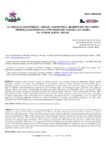Use este identificador para citar ou linkar para este item:
http://biblioteca.incaper.es.gov.br/digital/handle/item/431| Título: | As abelhas sem ferrão (Apidae: Meliponina) residentes no campus Federação/Ondina da Universidade Federal da Bahia, Salvador, Bahia, Brasil. |
| Autor(es): | SOUZA, S. G. X. de.  TEIXEIRA, A. F. R.   NEVES, E. L. das.   MELO, A. M. C. de.   Solon Guimarães Xavier de Souza; Alex Fabian Rabelo Teixeira, Incaper; Edinaldo Luz das Neves; Amada Mariana Costa de Melo.   |
| Palavras-chave: | Abelhas sem ferrão Áreas urbanas Riqueza de espécies |
| Data do documento: | 6-Jan-2015 |
| Editor: | Candombá (Revista Virtual), v. 1, n. 1, p. 57 69, 2005. |
| Descrição: | O presente estudo pretende responder às seguintes questões: quais espécies (riqueza) de Meliponina (Apidae) mantêm populações residentes no Campus Federação/Ondina da Universidade Federal da Bahia, Salvador, BA (CFO-UFBA)? Qual a abundância relativa dos ninhos dessas espécies? Qual a densidade desses ninhos? Qual a diversidade das espécies residentes? Quais os tipos de substratos predominantemente ocupados por essas abelhas? Quais as características desses substratos? Para tanto, foi realizado, durante três meses, o levantamento dos ninhos das abelhas Meliponina no CFO-UFBA. Foram registrados 94 ninhos pertencentes às espécies Tetragonisca angustula (Latreille, 1811); Trigona spinipes (Fabricius, 1793); Oxytrigona tataira (Smith, 1863); Plebeia droryana (Friese, 1900) e Nannotrigona testaceicornis (Lepeletier, 1836), sendo que a primeira apresentou a maior abundância de ninhos. A densidade de ninhos observados foi de 1,6 ninhos/ha, a diversidade H =0,83 e a equitabilidade J =0,51. A maioria das espécies foi encontrada nidificando em muros de pedra. A existência de cavidades pré-existentes artificiais e de áreas verdes heterogêneas no CFO-UFBA deve estar favorecendo a manutenção das populações dessas espécies na área. The aim of this study is answer the following questions: What is the species richness of stingless bees (Apidae: Meliponina)residents in Campus of Federal University of Bahia, Brazil? What is the relative abundance of the nests of these stingless bees species? What is the density of these nests? What is the Diversity of these species? What are the types of substrates preferentially used by these bee species to found their nests? What are the characteristics of these substrates? In order to answer these questions, we sampled during thee months the nests of stingless bees in Campus of Federal University of Bahia. We found 94 nests from the species Tetragonisca angustula (Latreille, 1811); Trigona spinipes (Fabricius, 1793); Oxytrigona tataira (Smith, 1863); Plebeia droryana (Friese, 1900) e Nannotrigona testaceicornis (Lepeletier, 1836). Nests of T. angustula were the more abundant ones. The density observed was 1.6 nests/ha, the diversity was H = 0,83 and the equitability was J=0,51. Muro de pedra was the substrate preferred to construct the nests. The availability of preexisting to construct the nests and patches of forests presents in Campus of Federal University of Bahia may improve the existence of the populations of these species in the area. |
| URI: | http://biblioteca.incaper.es.gov.br/digital/handle/item/431 |
| ISSN: | 1809-0362 |
| Aparece nas coleções: | Memória Técnica do Incaper  |
Arquivos associados a este item:
| Arquivo | Descrição | Tamanho | Formato | |
|---|---|---|---|---|
| Artigo-4-ALEX-FABIAN.pdf | 99,64 kB | Adobe PDF |  Visualizar/Abrir |
Os itens no repositório estão protegidos por copyright, com todos os direitos reservados, salvo quando é indicado o contrário.
